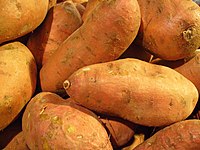
Photo from wikipedia
Polyploid rice hybrids have a powerful biological and yield potential that may become a new way for rice breeding; however, low fertility is major hindrance in commercial utilization. Here, we… Click to show full abstract
Polyploid rice hybrids have a powerful biological and yield potential that may become a new way for rice breeding; however, low fertility is major hindrance in commercial utilization. Here, we developed a neo-tetraploid rice that could overcome the sterility of autotetraploid rice and produce high heterosis. Transcriptome analysis of F1 hybrid developed by crossing neo-tetraploid with autotetraploid rice displayed 807, 663 and 866 differentially expressed genes that uniquely associated with F1 and specific to (DEGFu-sp) anther, ovary and leaf, respectively. Of the DEGFu-sp, 1224 genes displayed nonadditive expression; 44 and 10 genes were annotated as TFs and methyltransferase or hydroxymethyltransferase, respectively. Gene ontology enrichment and co-expression analysis revealed specific differential gene expressions in the DEGFu-sp to leaf, anther and ovary, such as genes related to photosynthesis, metabolic process and transport, and co-expression network including fertility, resistance and epigenetic elements. Of the DEGFu-sp to anther, 42 meiosis stage-specific genes, eight meiosis-related genes, such as RAD51 and SMC2, were identified. We identified 38 miRNAs from DEGFu-sp to anther, and their targets were associated with pollen fertility and retrotransposon protein. Our study provides new germplasm for polyploid rice breeding, and revealed complex regulatory mechanisms that might be associated with heterosis and fertility.
Journal Title: Scientific Reports
Year Published: 2017
Link to full text (if available)
Share on Social Media: Sign Up to like & get
recommendations!